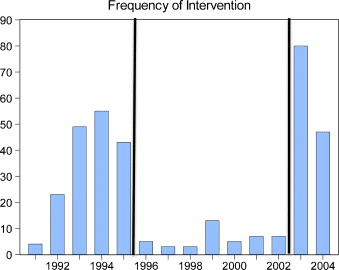
【日本の介入パターン💴】外国為替介入(FXI)のさまざまなパターンの有効性💖:先行研究要約 2024/1/12
今回は、外国為替介入(FXI)のさまざまなパターンの有効性について研究された論文をご紹介します💖
この先行研究の概要と結論のみのご紹介になりますが、英語学習も含めて読み進めていくことにしましょう!
卒業論文も完成間近💛
私もいよいよ卒業論文の執筆に
取りかかる時期がやって参りました👍
何事もアウトプット前提のインプットが
大事であると、noteで毎日発信してきました!
これは、どのような内容で
あっても当てはまります👍
論文を一概に読んでも
記憶に残っていなかったり
大切な観点を忘れてしまっていたりしたら
卒業論文の進捗は滞ってしまうと思います。
だからこそ、この「note」をフル活用して
卒業論文を1%でも
完成に向けて進めていきたいと思います!
収益化をすることはなく、先行研究などのコンテンツを正しく引用し、適切な発信ができるように努めます📝
私の卒論執筆への軌跡を
どうぞ最後までご愛読ください📖
今回の要約する先行研究🔥
今回、読み進めていく論文は
こちらになります📚
Japanese foreign exchange intervention: A tale of pattern, size, or frequency
Marwa Hassan
Faculty of Commerce, Alexandria University, Alexandria, Egypt
Japan and the World Economy 24 (2012) 184–192.
概要:Abstract📝
Abstract
This paper contributes to the debate of the efficacy of different patterns of foreign exchange intervention (FXI).
Daily data on the Japanese foreign exchange intervention and the Yen/Dollar exchange rates among other macroeconomic variables over the period 1992–2004, in an EGARCH time series model is used to measure the impact of intervention on both the level and volatility of the exchange rate.
この論文は、外国為替介入(FXI)のさまざまなパターンの有効性に関する議論に貢献します。
EGARCH時系列モデルでは、1992年から 2004 年の期間にわたる日本の為替介入とその他のマクロ経済変数の中での円/ドル為替レートに関する毎日のデータが、為替レートのレベルとボラティリティの両方に対する介入の影響を測定するために使用されます。
This paper offers two important results in regard to the effectiveness of the Japanese FXI.
First, this study tests whether the pattern of FXI leads to conflicting outcomes with respect to the desired level and volatility of the exchange rates.
Second, this study examines the asymmetric impact of the frequency and size of the Japanese FXI on the level and volatility of the exchange rate.
This paper finds that successful depreciation of the yen has always been achieved at the expense of higher volatility, a result that supports the conflicting outcomes of the Japanese FXI.
In addition, the frequency of intervention is found to be a crucial factor in affecting the level of the exchange rate while the size of intervention is more influential in affecting its volatility.
この論文は、日本のFXIの有効性に関して2つの重要な結果を提供します。
第一に、この研究は、FXIのパターンが為替レートの望ましいレベルとボラティリティに関して矛盾する結果をもたらすかどうかをテストします。
第二に、この研究は日本のFXIの頻度と規模が為替レートのレベルとボラティリティに及ぼす影響の非対称性を調べます。

この論文では、円安の成功は常にボラティリティの上昇を犠牲にして達成されており、その結果が日本のFXIの相反する結果を裏付けるものであることを発見したのです✨

この図は、1992年1月2日から2004年3月31日までの全期間における日本と米国のFXIオペレーションにおける円/米ドル為替レートの動きと為替レートの125ドル/円レベルを示しています!
結論:Conclusion📚
This study provides a detailed analysis of the impact of different patterns of the FXI.
The pattern of the Japanese FXI leads to conflicting outcomes on the level and volatility of the exchange rate. In other words, one objective may be achieved at the expense of forgoing the other objective. Successful depreciation of the yen has been always achieved at the expense of higher volatility.
One appealing contribution to this paper is the findings of FXI to the exchange rate volatility. Contrary to Frenkel et al. (2005), this paper finds that FXI reduces the volatility in the first period. Consistent to the literature, the paper also confirms the effectiveness in the first regime is different from the second and the third regimes.
To explain the regime difference, the paper proposes a frequency–size model of FXI that explicitly distinguish between the impact of the frequency and size of interventions on the level and volatility of the exchange rate, providing a detailed analysis of the effectiveness of different patterns of the Japanese FXI.
この調査では、FXI のさまざまなパターンの影響を詳細に分析しています。日本のFXIのパターンは、為替レートの水準とボラティリティに関して相反する結果をもたらします。
言い換えれば、1つの目的は他の目的を犠牲にして達成される可能性があります。
円安の成功は、常にボラティリティの上昇を犠牲にして達成されてきました。
この論文への魅力的な貢献の1つは、為替レートのボラティリティに関する FXIの調査結果です。
フレンケルらとは対照的に、(2005) によると、この論文では、FXIが最初の期間のボラティリティを低下させることがわかりました。
文献と一致して、この論文では、最初のレジームの有効性が2番目および3番目のレジームとは異なることも確認しています。
レジームの違いを説明するために、この論文では、周波数の影響を明確に区別するFXIの周波数-サイズ モデルを提案しています。
為替レートのレベルとボラティリティに関する介入の規模と、日本のFXIのさまざまなパターンの有効性の詳細な分析を行っているのです💗

1992年1月2日から2004年3月31日までの期間にわたる従属変数と独立変数の変動について、上図を参照してください。
I find that the impact of the frequency of FXI is more important on the level of exchange rate while it is less important on the volatility as compared to the size of intervention. For a given level of frequency, a change from a small to large intervention reduces the rate of appreciation of the exchange rate by 0.01 percent.
However, for a given size of intervention, a change from perfectly frequent to perfectly infrequent interventions improves the rate of depreciation by 0.1 percent, providing more evidence of why infrequent large interventions during the second period were more effective as compared to the frequent large interventions in the third period.
On the other hand small frequent intervention reduces the volatility while large frequent interventions increased the exchange rate volatility. Extending this approach of studying the effectiveness of FXI to emerging market economies while taking into consideration the spillover effects of changes in other related exchange rates in a VAR framework might be the direction of future research.
FXI の頻度の影響は、為替レートのレベルではより重要ですが、介入の規模と比較すると、ボラティリティではそれほど重要ではないことがわかりました。
特定の頻度レベルにおいて、小規模な介入から大規模な介入への変更は為替レートの上昇率を0.01パーセント低下させます。
ただし、特定の規模の介入では、完全に頻繁な介入から完全に低頻度の介入への変更により、為替レートの上昇率が向上します。
これは、第 3 期間で頻繁に大規模な介入を行った場合と比較して、第 2 期間でまれに大規模な介入を行った方がなぜより効果的であるかを示すさらなる証拠を提供します。
一方、小規模で頻繁な介入はボラティリティを低下させ、大規模で頻繁な介入は為替レートボラティリティを上昇させました。
VARの枠組みにおける他の関連為替レートの変動の波及効果を考慮しながら、FXIの有効性を研究するこのアプローチを新興市場国にも拡張することが、将来の研究の方向性となるかもしれませんね💛
読み終えた先行研究📚
『日本の為替介入の分析』
伊藤隆敏・著
経済研究 Vol.54 No.2 Apr. 2003
『Effects of the Bank of Japan’s intervention on yen/dollar exchange rate volatility』21 November 2004
Toshiaki Watanabe (a), Kimie Harada (b)
『The Effects of Japanese Foreign Exchange Intervention: GARCH Estimation and Change Point Detection』
Eric Hillebrand Gunther Schnabl Discussion
Paper No.6 October 2003
Official Japanese Intervention in the JPY/USD Exchange Rate Market: Is It Effective and Through Which Channel Does It Work?
Rasmus Fatum*
IMES Discussion Paper Series
2009-E-12 March 2009
私の研究テーマについて🔖
私は「為替介入の実証分析」をテーマに
卒業論文を執筆しようと考えています📝
日本経済を考えたときに、為替レートによって
貿易取引や経常収支が変化したり
株や証券、債権といった金融資産の収益率が
変化したりと日本経済と為替レートとは
切っても切れない縁があるのです💝
(円💴だけに・・・)
経済ショックによって
為替レートが変化すると
その影響は私たちの生活に大きく影響します
だからこそ、為替レートの安定性を
担保するような為替介入はマクロ経済政策に
おいても非常に重要な意義を持っていると
推測しています
決して学部生が楽して執筆できる
簡単なテーマを選択しているわけでは無いと信じています
ただ、この卒業論文をやり切ることが
私の学生生活の集大成となることは事実なので
最後までコツコツと取り組んで参ります🔥
本日の解説は、以上とします📝
今後も経済学理論集ならびに
社会課題に対する経済学的視点による説明など
有意義な内容を発信できるように
努めてまいりますので
今後とも宜しくお願いします🥺
マガジンのご紹介🔔
こちらのマガジンにて
卒業論文執筆への軌跡
エッセンシャル経済学理論集、ならびに
【国際経済学🌏】の基礎理論をまとめています
今後、さらにコンテンツを拡充できるように努めて参りますので何卒よろしくお願い申し上げます📚
最後までご愛読いただき誠に有難うございました!
あくまで、私の見解や思ったことを
まとめさせていただいてますが
その点に関しまして、ご了承ください🙏
この投稿をみてくださった方が
ほんの小さな事でも学びがあった!
考え方の引き出しが増えた!
読書から学べることが多い!
などなど、プラスの収穫があったのであれば
大変嬉しく思いますし、投稿作成の冥利に尽きます!!
お気軽にコメント、いいね「スキ」💖
そして、お差し支えなければ
フォロー&シェアをお願いしたいです👍
今後とも何卒よろしくお願いいたします!
この記事が気に入ったらサポートをしてみませんか?
